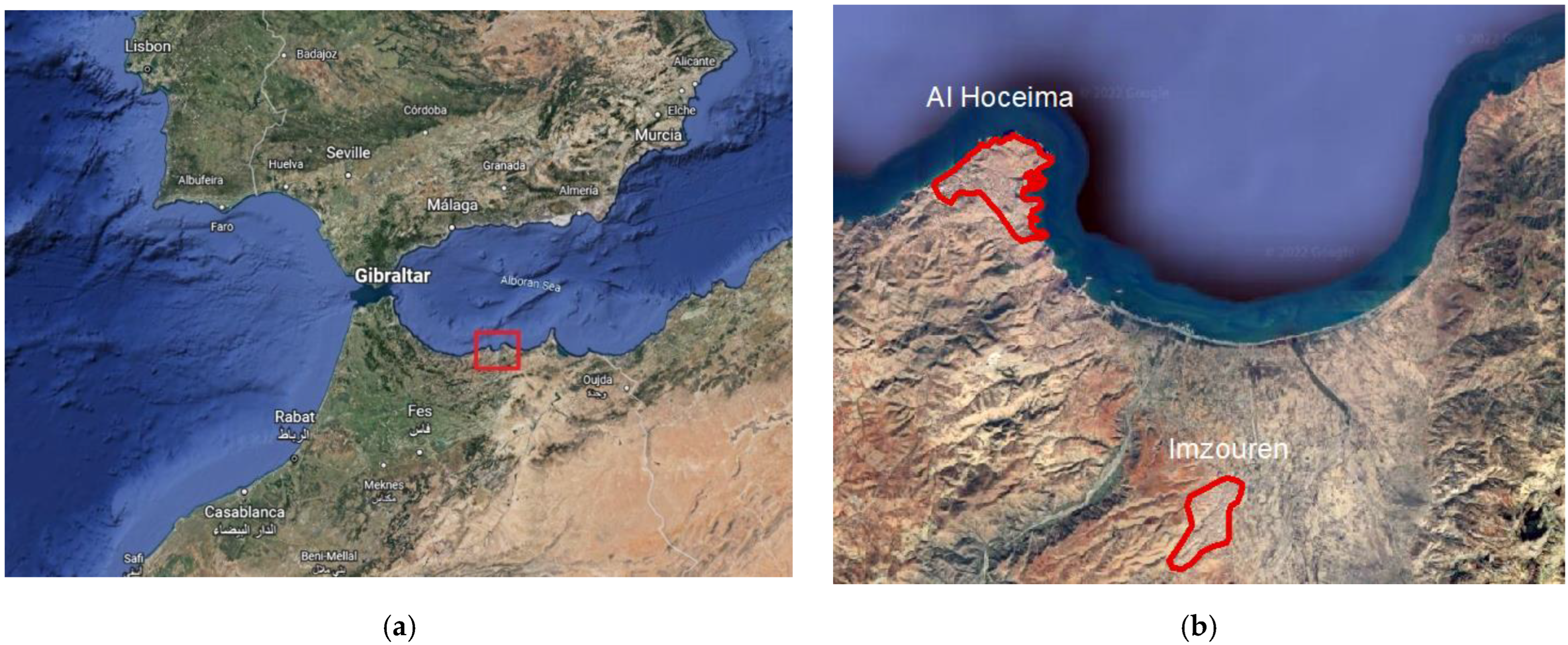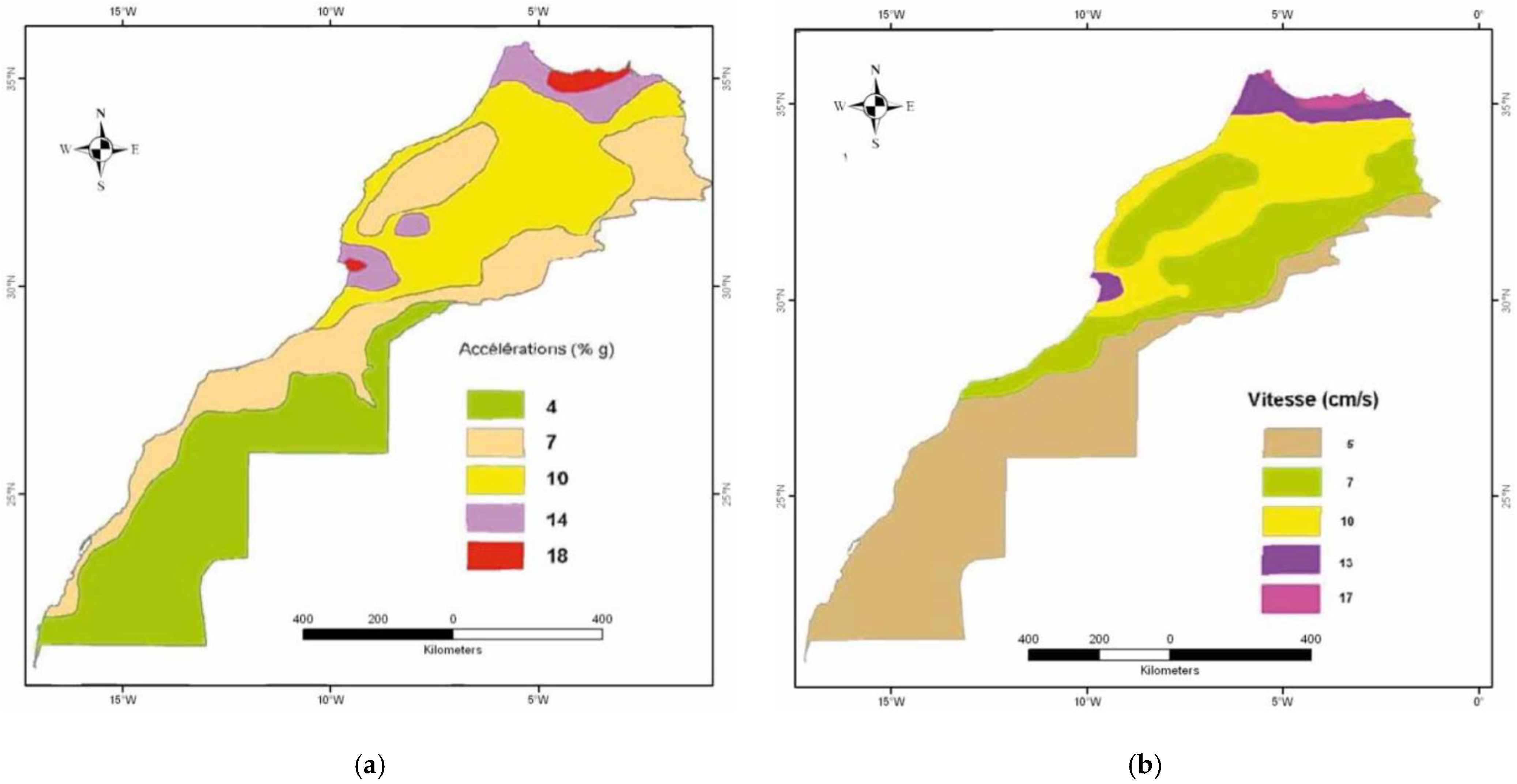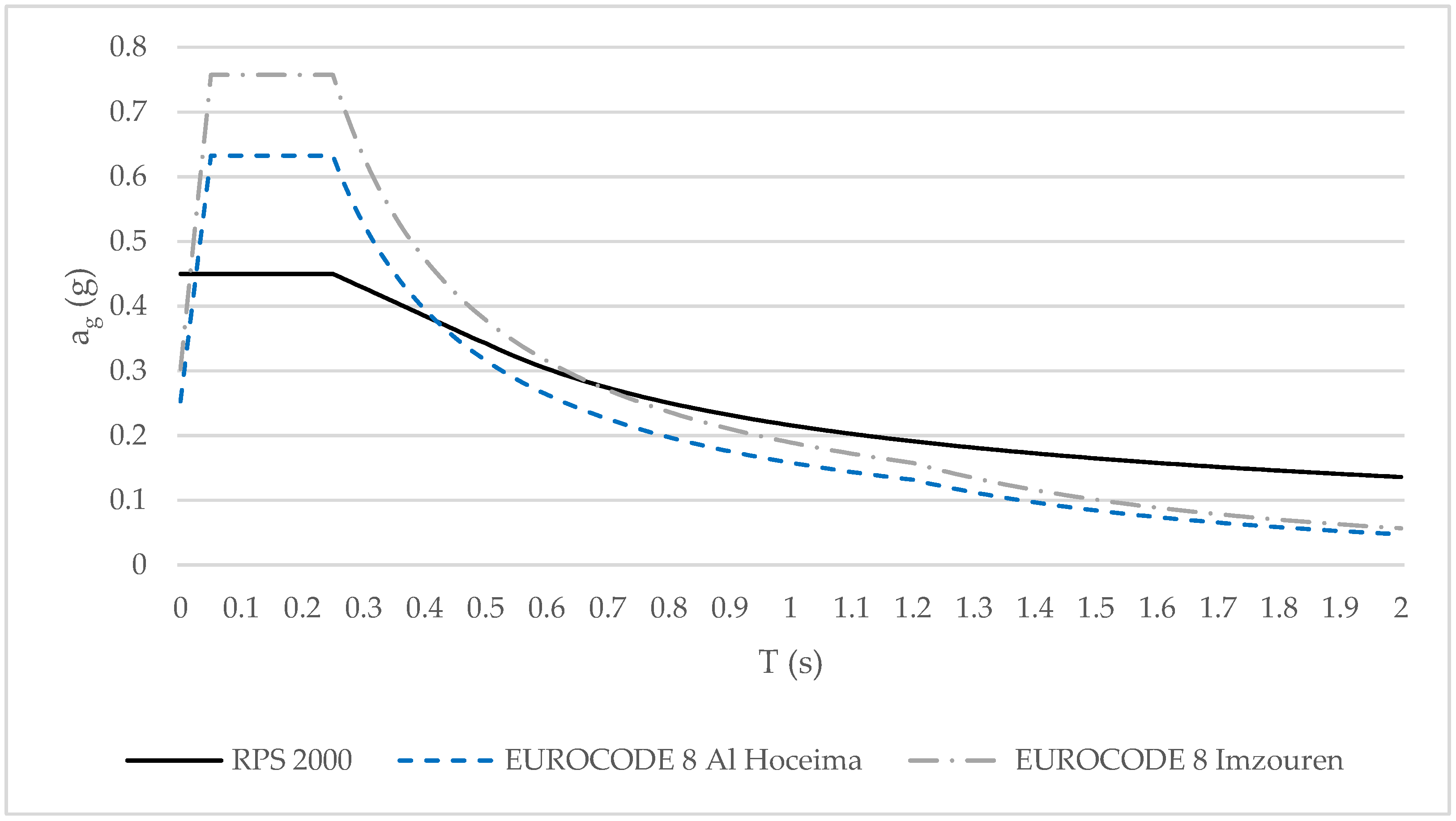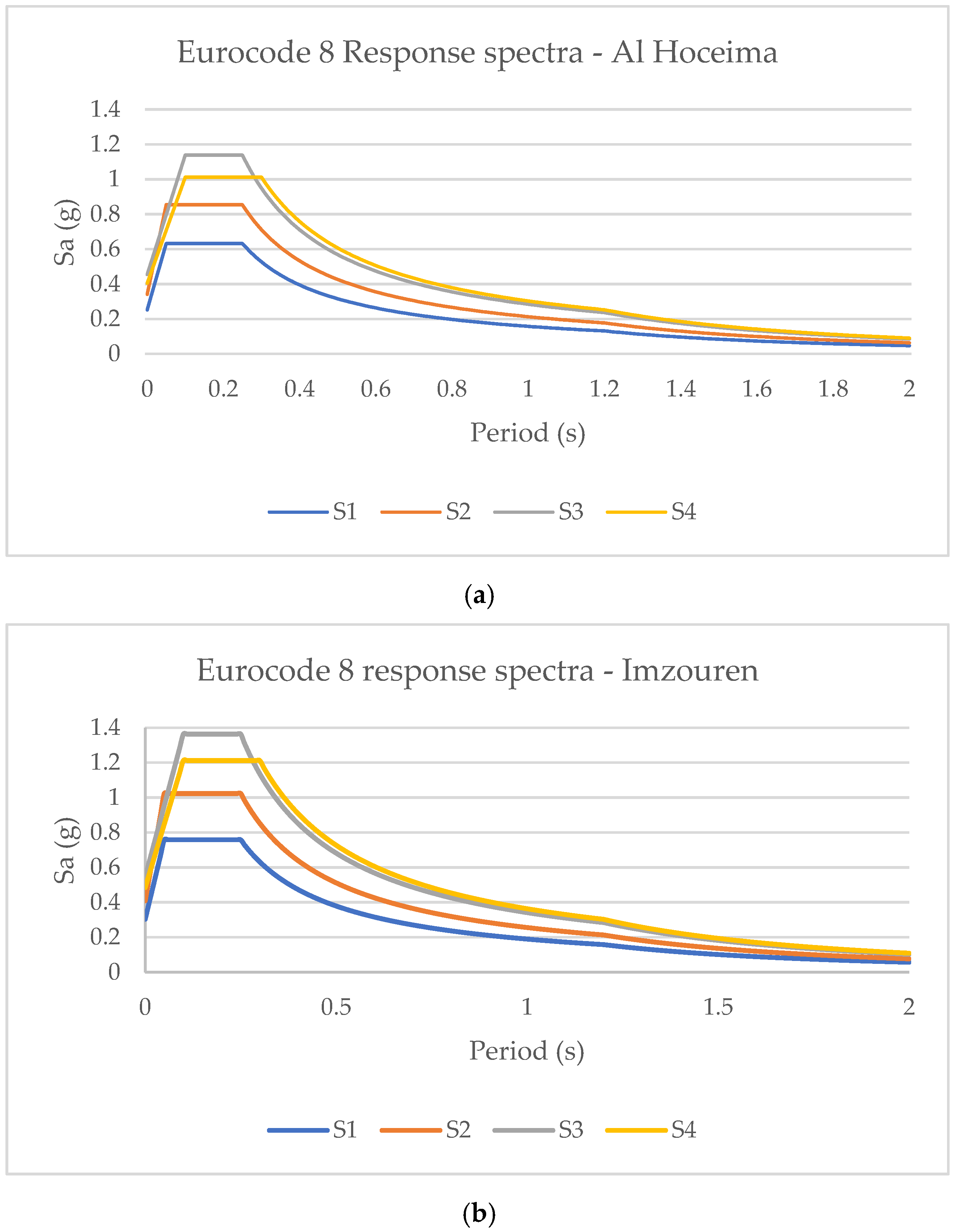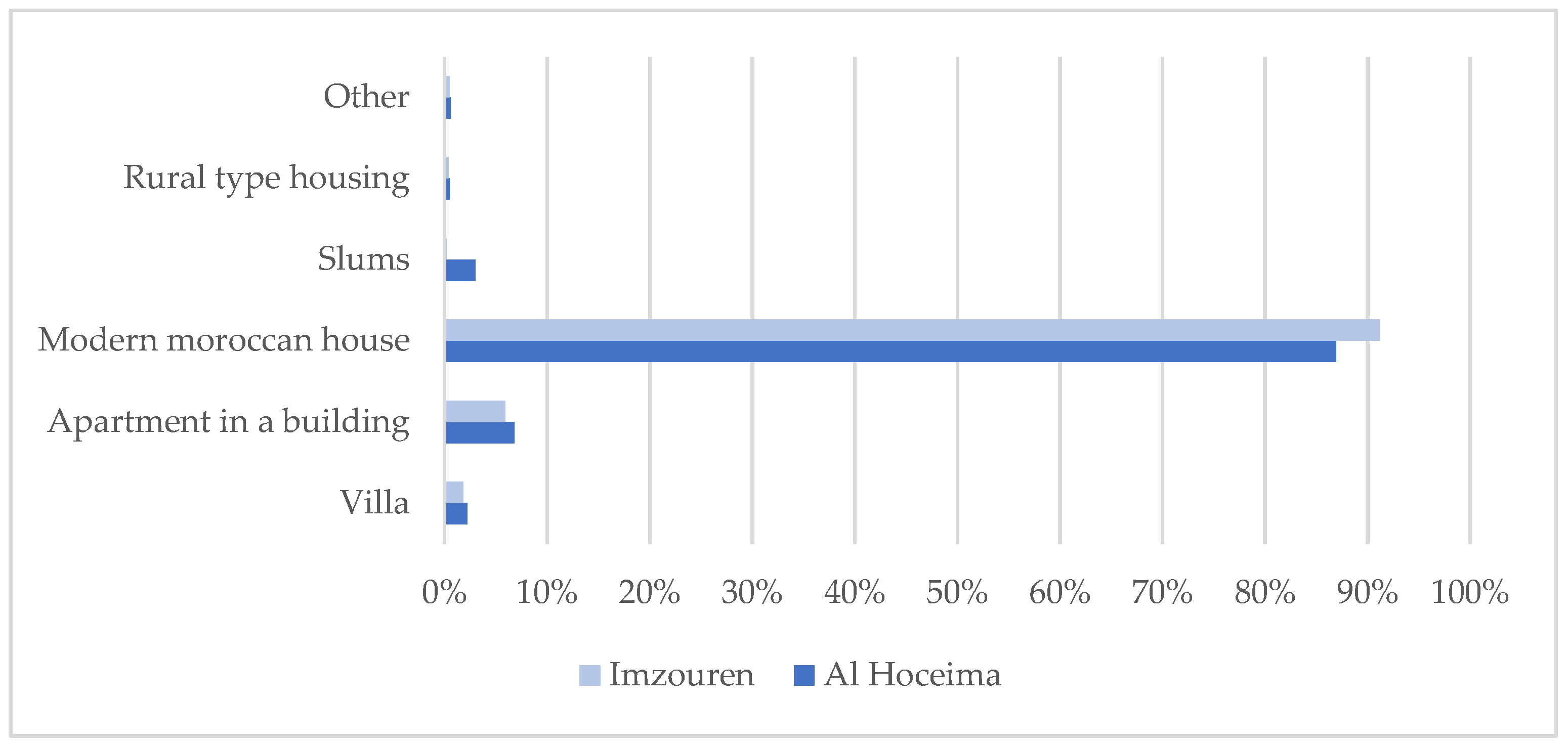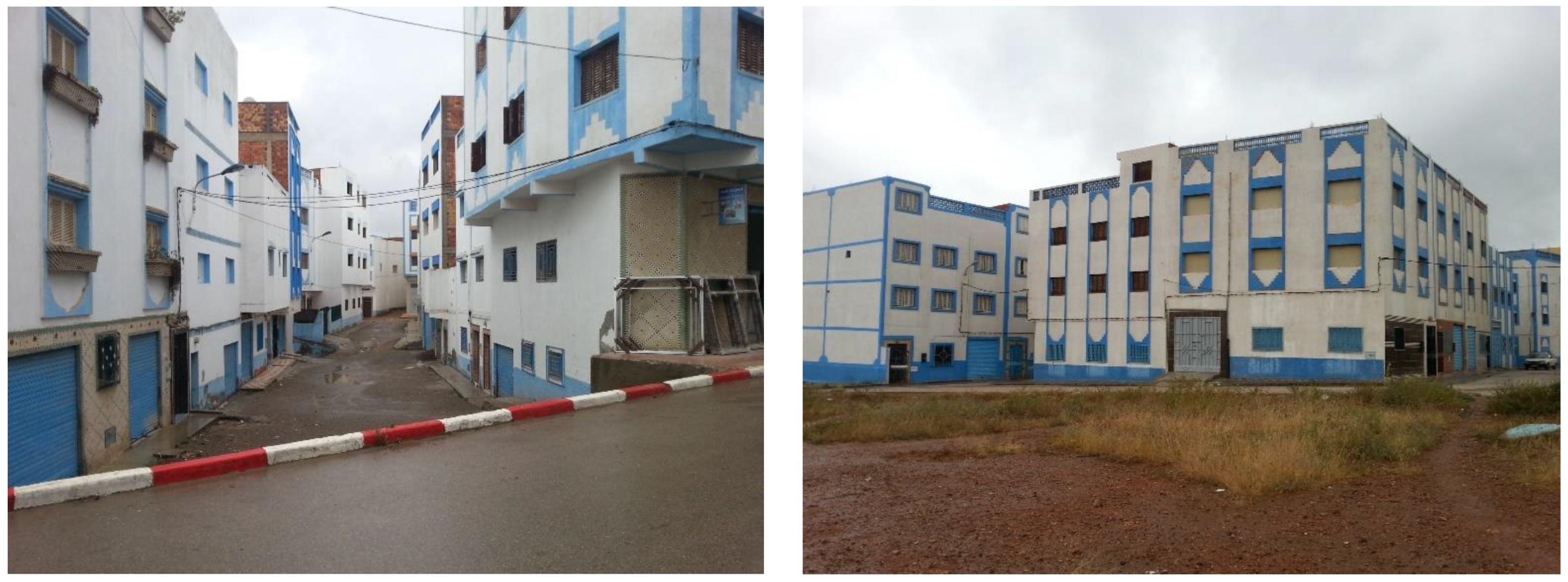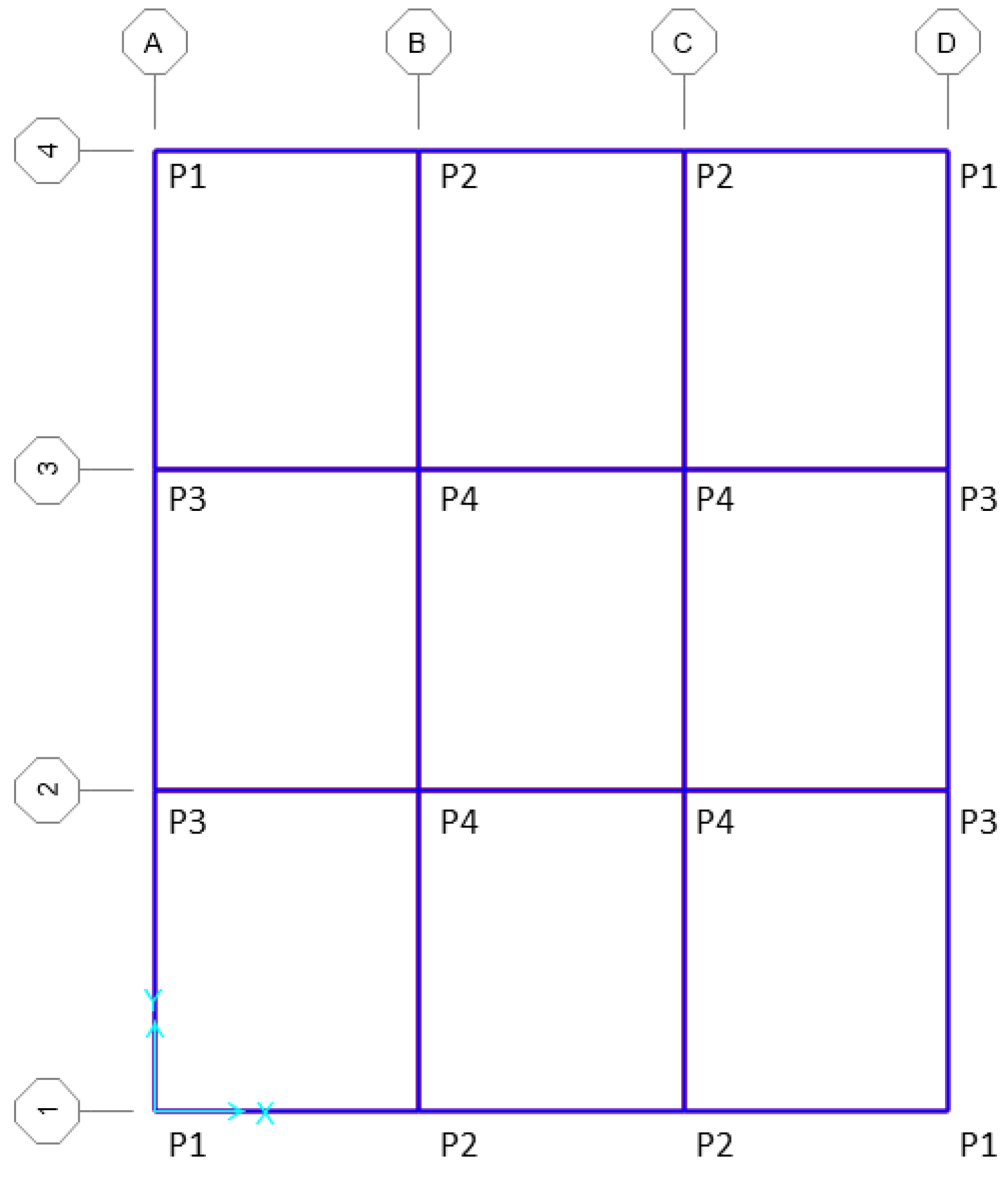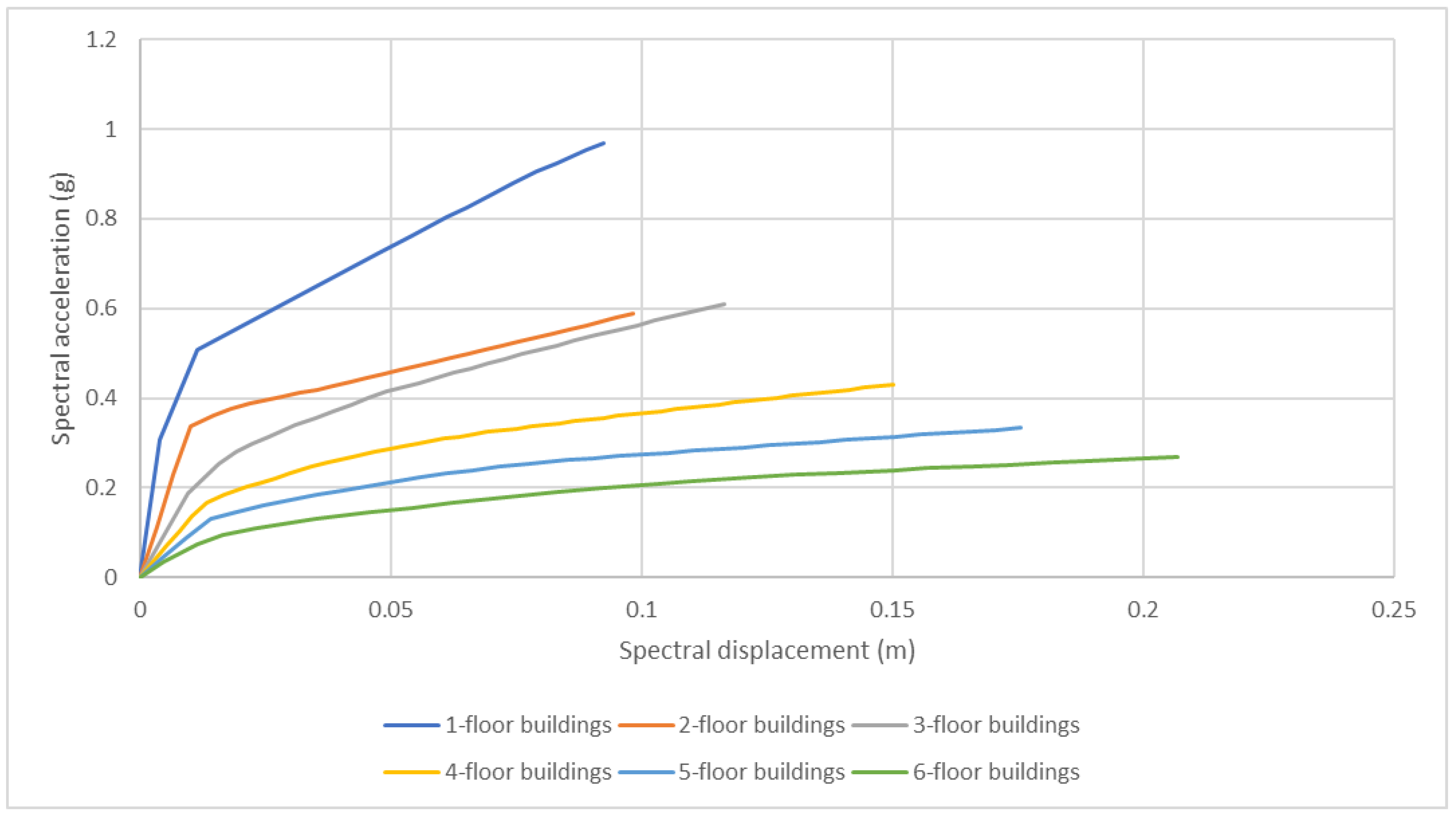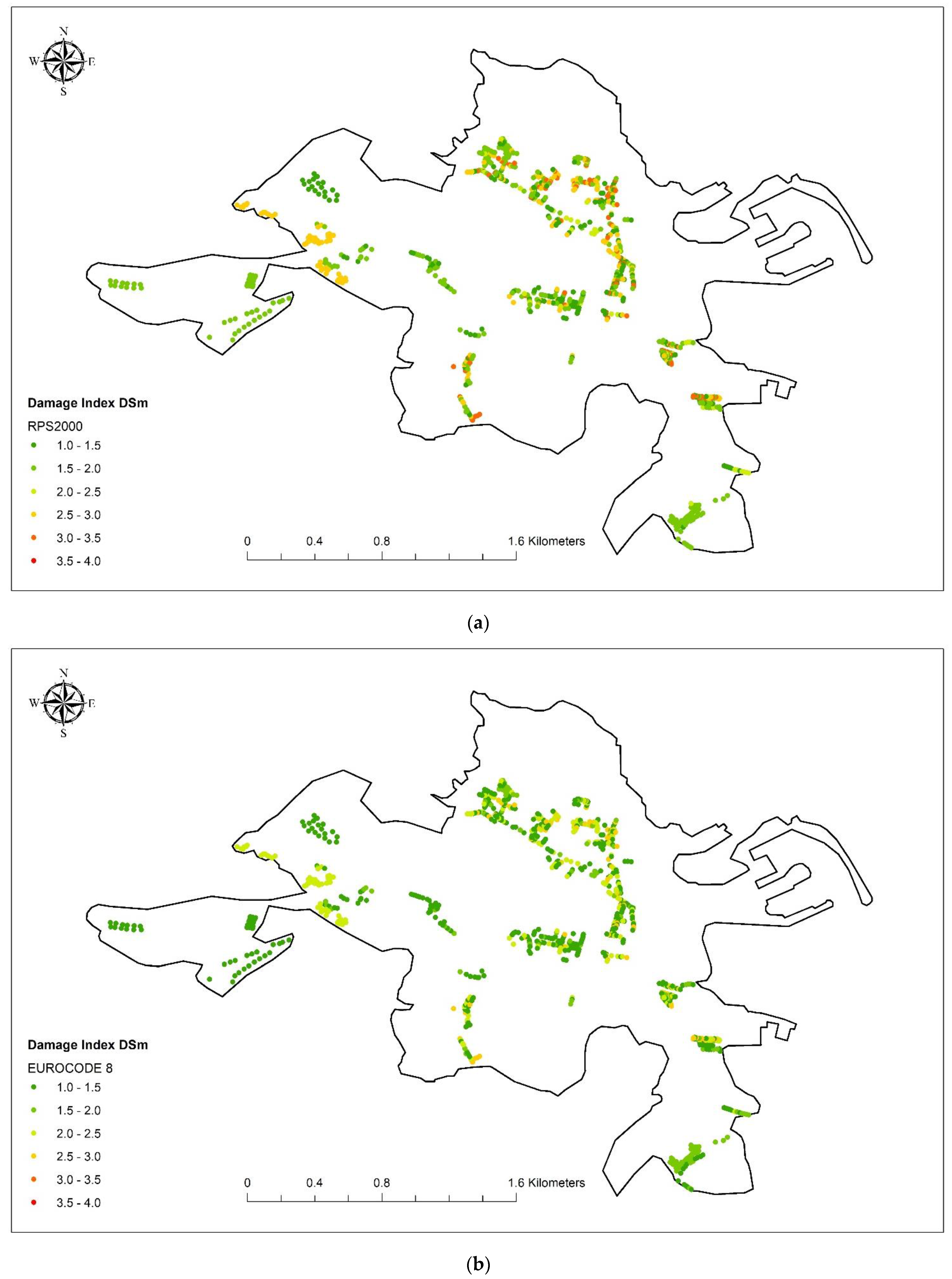1. Introduction
In Morocco, the rural world is lagging in terms of development indicators such as weak infrastructure, isolation, and insecurity. These structural weaknesses, combined with the droughts that occasionally affect the country, have strongly contributed to the rural exodus. In 1960, 71% of Moroccans lived in rural areas [
1]. In recent years, and mainly as a result of the rural exodus, less than 40% of the country’s population still live in rural areas [
2].
Across the country, urban planning has not been able to keep up with the significant increase in population following rural migration. The inadequate occupancy of the land contributes to increasing the damage due to seismic catastrophes. The high concentration of people, buildings, infrastructures, and exposed values turn these zones into high-risk areas. Districts that do not meet building standards are found in every city in Morocco. However, by adding moderate seismic activity to the equation, it becomes a recipe for disaster. This is the case for the urban and rural areas in the central Rif region.
The recent past has demonstrated that seismic risk is significant in this area [
3,
4]. Successive earthquake sequences between 1992 and 1994 [
5,
6], the 2004 earthquake [
7,
8,
9] and, more recently, the 2016 earthquake [
10,
11,
12], have caused fatalities and significant damage. Moderate seismicity combined with a high vulnerability of existing buildings and local site effects were mainly believed to be the causes of the extensive damage. On a larger scale, the Mediterranean region is no stranger to earthquakes of moderate intensity, causing significant damage. On the 12 June 2017, an earthquake of Mw = 6.3 struck Lesvos Island, causing one human fatality and severe damage to the built environment [
13]. An Mw = 6.4 earthquake hit the NW region of Albania on 26 November 2019, resulting in extensive damage to the civil structures in the broader area of Durrës city and its surroundings [
14]. More recently, a severe earthquake hit Zagreb on 22 March 2020 (magnitude ML = 5.5). The event occurred during the COVID-19 lockdown and caused significant damage to the built environment and enormous disruption in everyday life [
15].
Pre-emptive measures were eventually taken to reduce the damage. The introduction of a national seismic standard R.P.S. in 2002 [
16] and its revision in 2011 [
17] were one of the most important steps, along with multiple studies to estimate risk aiming to guide the decision making at the urban level. In the literature, several methods are suitable to solve this kind of problem on a large scale and can be categorized into three classes [
18,
19]: (i) Empirical methods, based on damage reports following earthquakes and building characteristics to estimate a seismic vulnerability index. These empirical methods were the only reasonable approaches that could be used in a large-scale seismic hazard analysis [
20,
21,
22,
23,
24,
25,
26]; (ii) mechanical and analytical methods, which are more detailed but laborious for a large-scale study. They use slightly more detailed algorithms for vulnerability assessments, which allow more delicate and detailed studies [
27,
28,
29,
30]; (iii) hybrid methods, which can be particularly advantageous in the absence of damage data at certain levels of intensity for the geographical area considered and they also make it possible to adjust the analytical model. Furthermore, the use of observational data reduces the computational effort that would be required to produce a full set of analytical vulnerability curves [
31,
32].
In recent years, the use of the Georeferenced Information System (GIS) has gained momentum in civil engineering applications, especially in the field of risk assessment on a large scale. One cannot deny the increase in popularity of data collection for seismic vulnerability and risk assessment and some proposals have been developed to rapidly obtain a large amount of information processing images of wide sets of existing buildings. For instance, the Global Earthquake Model (GEM) has been developing an open global earthquake risk model [
33]. These efforts have led to the development of a repository of probabilistic seismic hazard models, a global exposure dataset comprising structural and occupancy information regarding the residential, commercial, and industrial buildings, and a comprehensive set of fragility and vulnerability functions for the most common building classes. These components were used to estimate probabilistic earthquake risk globally using the OpenQuake Engine, an open-source software for seismic hazard and risk analysis [
34,
35].
In Morocco, the first adapted methods are the European macroseismic scale and vulnerability index methods [
36,
37,
38]. These approaches are time consuming in gathering data, but they are easy to apply and show conclusive results. Other studies like the seismic index [
39] tried to tackle the problem differently by adapting the Japanese Seismic Index Method, making it more time efficient and tuned to the context of Moroccan construction.
The present study follows the same strategy of estimating damage in the region by considering an advanced model to evaluate seismic risk in the cities of Al Hoceima and Imzouren. It is a predictive model obtained by applying the Capacity Spectrum Based Method (CSBM). The method considers four damage states in addition to a no-damage state [
40]. Seismic action is defined in terms of response spectra and building vulnerability is evaluated through its capacity spectrum. A probabilistic seismic hazard scenario with a probability of exceedance of 10% in 50 years, in which soil effects are considered, is used herein.
Capacity curves are developed from building models representative of the building typologies present in the study area. These models have been designed in previous studies based on a database gathered over the years [
37,
38,
39]. Since 2014, information on existing buildings in the region has been collected, catalogued, and analyzed. The gathered information is based on field investigations, design and reinforced plans of some buildings, and information from consulting civil engineering offices working on residential buildings in the region.
The obtained results are stored and displayed in a GIS model where the predictive damage of buildings in both cities is spatially represented. The detailed risk maps obtained offer an excellent opportunity to guide the decision making in the field of seismic risk prevention, preparedness, and mitigation in the central Rif region. The study would also constitute the first step towards a newer and more reliable version of the national seismic standard R.P.S. [
17].
2. Capacity Spectrum Based Method
The Capacity Spectrum Based Method (CSBM) [
41] is a performance-based seismic analysis technique and may be used for a variety of purposes and on different scales. The approach can potentially be a time-efficient evaluation of a large inventory of buildings on a large scale, or on a smaller scale, an assessment of the seismic performance of a new or an existing structure to estimate its damage state. The CSBM was developed by Freeman to be a rapid evaluation procedure for assessing the seismic vulnerability of buildings at the Puget Sound Naval Shipyard [
42]. The procedure compares the capacity of a structure with the demand of earthquake motion on the structure.
The capacity of the structure is represented in terms of a force-displacement curve obtained from a non-linear static (pushover) analysis. The shear force and roof displacement are converted to a spectral acceleration and spectral displacement of an equivalent Single Degree of Freedom (SDOF) system. The earthquake demand curve is represented by response spectra. An Acceleration/Displacement Response Spectrum (ADRS) format [
43], where spectral accelerations are plotted against spectral displacements, is used. The graphical superposition of the two curves makes possible a visual evaluation of how the structure will perform under earthquake ground motion.
The CSBM considers five damage states: slight, moderate, severe, and complete, including the none damage state. For reinforced concrete buildings, these damage states have the same meaning as in HAZUS [
44]. The only exception is the complete damage state, which is subdivided into two states: very heavy and destruction, as per the 1998 European Macroseismic Scale [
45]. A weighted average damage index,
can be calculated as:
where
takes the values 0, 1, 2, 3, and 4 for the damage states
considered in the analysis and
are the corresponding probabilities. It can be considered that
is close to the most likely damage state of the structure. The damage index
will be useful for representing and analyzing damage distributions by using a single parameter.
Fragility curves define the probability that the expected damage
of a structure exceeds a given damage state
, as a function of a parameter quantifying the severity of the seismic action. In this study, the quantifying parameter is the spectral displacement
. It is usually assumed that fragility curves are well described by the following lognormal probability density function:
where
is the threshold spectral displacement at which the probability of the damage state
is 50%,
is the standard deviation of the natural logarithm of this spectral displacement,
is the standard cumulative distribution function, and
is the spectral displacement.
Capacity spectra are approximated with bilinear curves using FEMA 273 guidelines [
46].
Table 1 shows how the thresholds
are obtained as a function of the yield displacement
and the ultimate displacement
of the structure. Concerning
, it is well known that the expected seismic damage in buildings follows a binomial probability distribution [
45].
is calculated directly as a function of ultimate ductility
[
40] and is displayed in
Table 1.
5. Final Remarks
Seismic risk assessment based on the Capacity Spectrum method was used in this study and applied to the buildings of Al Hoceima and Imzouren, the most important towns of the central Rif region in Morocco. The region has experienced devastating earthquakes in the recent past and multiple studies have been carried out to assess the vulnerability and seismic risk of buildings in the region. This study falls within this framework, where importance is given to the development of building capacity spectra for the estimation of seismic performance. Two probabilistic risk scenarios were considered, using 5% damped elastic response spectra. The first scenario is based on the response spectrum taken from the national seismic code RPS2000, while the second scenario is based on the response spectrum model of Eurocode 8, using the seismic parameters and properties of the central Rif region. Response spectra were generated for four types of soil, ranging from rocky soil to soft soil.
The capacity spectra were developed for 36 building models, which were designed to represent the two cities’ most common types of structures. The model determination is related to the seismic code, the construction period, and the number of floors. Capacity spectra were generated by performing a non-linear pushover analysis. Fragility curves were estimated for the building models, following capacity spectra. They are used to estimate the damage induced following a chosen seismic action. By specifying the spectral displacement of the structure, one can build damage probability matrices and calculate the average damage index. Performance points for each model and each suggested risk scenario are calculated afterwards. The adopted method was applied to the buildings of the city of Al Hoceima and Imzouren. A database of 2746 existing buildings in the region was used to carry out this study. The damage estimate was made by calculating the average damage index.
The most important results show that the damage is more significant in Imzouren than in Al Hoceima, mainly because of the seismic hazard and the soil typology. The distribution of damage in the two cities is quite similar to previous studies carried out in the same cities. Buildings with high damage indices are mainly high vulnerability buildings in the city of Al Hoceima and buildings that do not comply with earthquake regulations and are built on loose soil in Imzouren. By reflecting on the risk scenarios considered, the credibility of the response spectra drawn from the RPS2000 is questioned, given the extreme damage estimated, especially in Imzouren, and which do not reflect the results found in studies carried out previously. The models of the response spectra derived from the Eurocode and adapted to the seismic properties of the region prove to be a reliable model for future studies in the region.
The results related to the capacity spectra and fragility curves, as well as the generated seismic risk maps, constitute a valuable source of information that can be used to support effective seismic risk mitigation and management actions in the central Rif region. However, it is part of a broader vision for a better understanding of the seismic risk in the Rif region. The limitations of the work will be explored in future projects that will revolve around the following points:
Expanding the existing databases and planning investigations in the rural areas of the Rif chain.
Developing response spectra of target regions using seismograph recordings.
Estimating site effects using shear wave velocity vs30.
Considering new building models such as shear wall structures or mixed structures, which became widespread after the seismic regulations.
